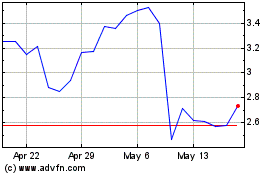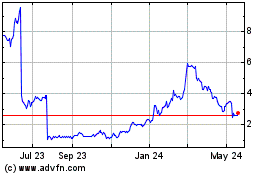Mersana Therapeutics, Inc. (NASDAQ: MRSN), a clinical-stage
biopharmaceutical company focused on discovering and developing a
pipeline of antibody-drug conjugates (ADCs) targeting cancers in
areas of high unmet medical need, today announced positive initial
clinical data from the Phase 1 dose escalation and backfill cohorts
for emiltatug ledadotin (Emi-Le; XMT-1660), Mersana’s lead
Dolasynthen ADC candidate targeting B7-H4.
“We believe the initial safety, tolerability and efficacy data
for Emi-Le demonstrate a profile that is exciting and
differentiated within both the B7-H4 field and the broader ADC
landscape,” said Martin Huber, M.D., President and Chief Executive
Officer of Mersana Therapeutics. “We have observed clinical
activity across tumors, including in heavily pre-treated patients
with TNBC. These clinical data have led us to initiate expansion in
patients with TNBC who have previously been treated with at least
one topo-1 ADC, a population with very high unmet need.”
As of a December 13, 2024 data cutoff, the dose escalation
portion of the Emi-Le Phase 1 clinical trial enrolled a total of
130 patients with advanced/metastatic TNBC;
hormone-receptor-positive, human epidermal growth factor receptor 2
negative breast cancer; ovarian cancer; endometrial cancer and
adenoid cystic carcinoma type 1. The enrolled patient population
was heavily pretreated, with patients receiving up to 15 and a
median of 4.5 prior lines of therapy, and approximately 92% of
enrolled patients with TNBC had been previously treated with at
least one topo-1 ADC. Among the 103 patients with known B7-H4 tumor
expression, approximately 44% had a tumor proportion score of 70%
or higher, which Mersana has preliminarily characterized as “B7-H4
high.”
Emi-Le was observed to be generally well tolerated, with no
Grade 4 or 5 treatment-related adverse events (TRAEs) reported. The
most common TRAEs of any grade across the entire patient population
were transient aspartate aminotransferase (AST) increase (38% of
patients), generally asymptomatic and reversible proteinuria (31%),
generally low-grade nausea (29%) and low-grade fatigue (28%). The
only Grade 3 TRAEs in ≥5% or more of all patients were AST increase
(14%) and proteinuria (9%). Across the entire enrolled patient
population, TRAEs leading to discontinuation, dose reduction and
dose delay were observed in 2.3%, 9.2% and 12.3% of patients,
respectively. No dose-limiting treatment-related neutropenia,
neuropathy, ocular toxicity, interstitial lung disease or
thrombocytopenia were reported, which the company believes
differentiates Emi-Le from many other approved and clinical-stage
ADCs.
At intermediate doses in the trial (38.1 mg/m2 to 67.4 mg/m2),
the confirmed objective response rate (ORR) among evaluable
patients (those with measurable disease at baseline and at least
one post-baseline scan) was 23% (6 of 26 patients) across all B7-H4
high tumors and 23% (3 of 13 patients) with B7-H4 high TNBC, all of
whom had previously been treated with at least one topo-1 ADC.
In the ASCENT Phase 3 clinical trial of sacituzumab govitecan, a
topo-1 ADC, the ORR with standard-of-care single-agent chemotherapy
in relapsed/refractory TNBC was approximately 5% with progression
free survival of approximately seven weeks. Based on these
encouraging Emi-Le data at intermediate doses, Mersana has advanced
a dose of 67.4 mg/m2 every four weeks (Q4W) into an expansion
cohort in patients with TNBC who have received one to four prior
treatment lines, including at least one prior topo-1 ADC.
“In terms of both tolerability and clinical activity, these
Emi-Le data are encouraging,” Erika Hamilton, M.D., Director Breast
Cancer Research, Sarah Cannon Research Institute in Nashville,
Tennessee, said. “It is notable that all the TNBC patients who
responded to Emi-Le had previously been treated with at least one
topo-1 ADC. The results indicate that Emi-Le may help address an
already substantial and growing need among topo-1 experienced
breast cancer patients for new treatments.”
At high doses above 76 mg/m2, the confirmed ORR among evaluable
patients was 22% (2 of 9 patients) across all B7-H4 high tumors.
Additionally, 78% (7 of 9 patients) had ≥30% tumor reduction in
target lesions. At these high dose levels, objective responses in
multiple evaluable patients with B7-H4 high tumors were not
confirmed after protocol-mandated dose delays for proteinuria.
Mersana is implementing proteinuria mitigation efforts and
continues to explore higher doses in dose escalation and backfill
cohorts to identify a second dose for the expansion portion of the
trial.
Mersana’s Expected 2025 Milestones and Areas of
Focus
Emi-Le
- 1H2025: Continue enrollment in expansion at a dose of 67.4
mg/m2 Q4W in patients with TNBC who have previously received at
least one prior topo-1 ADC
- 2025: Initiate enrollment in expansion at a second dose in
patients with TNBC who have previously received at least one prior
topo-1 ADC
- 2025: Present additional Phase 1 clinical data from dose
escalation and backfill cohorts
XMT-2056, Mersana’s lead Immunosynthen ADC targeting a
novel HER2 epitope
- 2025: Present initial clinical pharmacodynamic STING activation
data
Pipeline
- Continue to support internal pipeline and existing
collaborations with Johnson & Johnson and Merck KGaA,
Darmstadt, Germany
Conference Call InformationMersana will host a
conference call today at 8:30 a.m. ET to discuss the initial
clinical data from its Phase 1 clinical trial of Emi-Le. To access
the call, please dial 833-255-2826 (domestic) or 412-317-0689
(international). A live webcast that includes the data presentation
will be available on the Investors & Media section of the
Mersana website at www.mersana.com, and a replay of the
webcast will be available in the same location following the
conference call for approximately 90 days.
About Mersana TherapeuticsMersana Therapeutics
is a clinical-stage biopharmaceutical company focused on the
development of novel antibody-drug conjugates (ADCs) and driven by
the knowledge that patients are waiting for new treatment options.
The company has developed proprietary cytotoxic (Dolasynthen) and
immunostimulatory (Immunosynthen) ADC platforms that are generating
a pipeline of wholly-owned and partnered product candidates with
the potential to treat a range of cancers. Its pipeline includes
Emi-Le (emiltatug ledadotin; XMT-1660), a Dolasynthen ADC targeting
B7-H4, and XMT-2056, an Immunosynthen ADC targeting a novel epitope
of human epidermal growth factor receptor 2 (HER2). Mersana
routinely posts information that may be useful to investors on the
“Investors & Media” section of its website at
www.mersana.com.
Forward-Looking StatementsThis press release
contains “forward-looking” statements and information within the
meaning of the Private Securities Litigation Reform Act of 1995.
These statements may be identified by words such as “aims,”
“anticipates,” “believes,” “could,” “estimates,” “expects,”
“forecasts,” “goal,” “intends,” “may,” “plans,” “possible,”
“potential,” “seeks,” “will” and variations of these words or
similar expressions, although not all forward-looking statements
contain these words. Forward-looking statements in this press
release include, but are not limited to, statements concerning
Mersana’s plans regarding the clinical development of Emi-Le and
XMT-2056, including with respect to the progress and design of the
clinical trials of these product candidates; the potential clinical
benefits of Emi-Le; Mersana’s efforts to identify an additional
dose for investigation in the expansion portion of its Phase 1
clinical trial of Emi-Le; Mersana’s planned data presentations,
including with respect to its Phase 1 clinical trial of Emi-Le and
to clinical pharmacodynamic STING activation data related to
XMT-2056; Mersana’s collaborations with third parties; and the
development and potential of Mersana’s product candidates,
platforms, technology and pipeline of ADC candidates. Mersana may
not actually achieve the plans, intentions or expectations
disclosed in these forward-looking statements, and you should not
place undue reliance on these forward-looking statements. Actual
results or events could differ materially from the plans,
intentions and expectations disclosed in these forward-looking
statements as a result of various factors, including, among other
things, uncertainties inherent in research and development, in the
advancement, progression and completion of clinical trials and in
the clinical development of Mersana’s product candidates, including
Emi-Le and XMT-2056; the risk that Mersana may face delays in
patient enrollment in its Phase 1 clinical trials of Emi-Le and
XMT-2056; the risk that outcomes of preclinical studies may not be
predictive of clinical trial results; the risk that initial or
interim results from a clinical trial may not be predictive of the
final results of the trial or the results of future trials; the
risk that clinical trial data may not support regulatory
applications or approvals; the risk that Mersana may not realize
the intended benefits of its platforms, technology and
collaborations; and other important factors, any of which could
cause Mersana’s actual results to differ from those contained in
the forward-looking statements, that are described in greater
detail in the section entitled “Risk Factors” in Mersana’s
Quarterly Report on Form 10-Q filed with the Securities and
Exchange Commission (“SEC”) on November 13, 2024, as well as in
other filings Mersana may make with the SEC in the future. Any
forward-looking statements contained in this press release speak
only as of the date hereof, and Mersana expressly disclaims any
obligation to update any forward-looking statements contained
herein, whether because of any new information, future events,
changed circumstances or otherwise, except as otherwise required by
law.
Contact:Jason Fredette
617-498-0020jason.fredette@mersana.com
Mersana Therapeutics (NASDAQ:MRSN)
Historical Stock Chart
From Dec 2024 to Jan 2025

Mersana Therapeutics (NASDAQ:MRSN)
Historical Stock Chart
From Jan 2024 to Jan 2025
